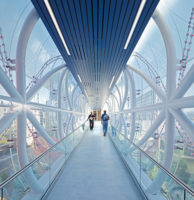Montgomery County, Md. is generating significant buzz among U.S. municipalities aiming to reduce greenhouse gas emissions from buildings.
After tightening eligibility requirements last September for an over-subscribed green building tax credit, the county council has upped the ante by proposing its mandatory building energy performance standards in legislation introduced May 4, with an initial hearing set for June 15. If approved, the bill requiring existing buildings to meet ambitious energy reduction goals by 2035 would make Montgomery the first U.S. county to enact such standards. A handful of cities and states, including St. Louis, Mo.; Washington, D.C.; New York City, and Washington State, have enacted similar measures.
Montgomery County also was the first to adopt a mandatory energy benchmarking law in 2014.
Jennifer Wellman-Andryuk, U.S. Green Building Council program manager for the national capital region, says updating incentives and other green building policies to align with ever-more stringent building codes isn’t unusual; the 2018 International Green Construction Code is the most demanding to date, she notes.
Montgomery County was one of the first jurisdictions in the country to adopt the code. “What’s different about Montgomery County is how far it is going,” she says. “It is a leader in terms of its overall goals toward climate change, and how far it is willing to go to ensure the built environment in the county is keeping pace with those goals.”
Big Picture
If enacted, the standards would apply to all commercial, residential and county-owned buildings larger than 25,000 sq ft. Building owners would be required to meet specific targets based on energy benchmarking data from existing local buildings, says Lindsey Shaw, county Dept. of Environmental Protection manager of energy and sustainability programs. The county benchmarking law is “the foundational building block on which we are basing our building energy performance standards,” she notes. It requires the county and building owners to use Energy Star to benchmark and disclose energy usage in certain non-residential buildings larger than 50,000 sq ft.
The standards would provide a trajectory for each type of building, with different requirements based on building type and size, set at four-year intervals through the early 2030s.
According to department director Adam Ortiz, revamping local green building requirements is part of a larger strategy to address climate change. He says the county is deeply involved in a climate change planning process to be able to meet its net zero goal by 2035. The new tax incentive program “is one of the first policies out of the gate, but we have a whole bunch of other stuff that we really think is going to shape the future of policy and green building to come,” Ortiz says.
These include policies such as the proposed performance standards, as well as those that would go well beyond buildings such as greening transportation in the county.
Since the tax incentive program inception in 2008, the county has awarded more than $33.4 million in credits. But as achieving green building certification has become more commonplace, the program has been oversubscribed.
The new tax credit framework raises the bar for building owners. They now must go beyond obtaining a Green Building Council Leadership in Energy and Environmental Design (LEED) certification or equivalent.
The county program will tie the credit to the amount of predicted energy reduction level relative to the existing building code. The higher the energy reduction level, the higher the credit. Buildings that reach the first tier receive additional credit if they meet the highest level of widely used green building certifications, such as LEED or BREEAM, the British green building equivalent. Building owners can still apply for the credits under the old program through January.
By now, as far as construction goes, “It’s almost impossible not to do the right thing” by building green, says Avi Halpert, vice president of corporate real estate at United Therapeutics Corp., which built a net-zero energy and emissions headquarters in Silver Spring, Md. that goes well beyond county requirements.
The 210,000-sq-ft structure, which is one of the largest net-zero commercial towers in the U.S., was recognized as ENR's best green project for 2019 and was a finalist for project of the year.
Halpert notes that getting a healthcare-focused net-zero building permitted and actually built in the county was not without hiccups. It took nearly four times as long to gain the permit to build the project in Montgomery County than a similar building in Durham, N.C., he says. That could factor into some larger developer decisions in where to locate new office buildings, Halpert says.
Carrot and Stick
The Institute for Market Transformation, which has provided technical support to the county since 2019 through the City Energy Project, a joint program with the Natural Resources Defense Council, is particularly excited about the county performance standards legislation, which it says gives building owners both medium- and long-range reduction milestones they need to reach.
“This is a real change from energy benchmarking, where it’s just a requirement to measure energy consumption,” says Zach Hart, institute associate director of building performance policy.
What is particularly innovative about Montgomery County’s program is that it provides some flexibility to owners who might have trouble meeting the short-term goals because of capital planning cycles, leases, or other challenges, but who will still meet the long-term goals, he says.
The county has not yet put actual numeric targets into the standards. That will come later through additional regulation if the legislation passes the council.
“We do have some pretty aggressive goals and requirements, [regarding meeting 2035 net-zero goals], but we try to provide a carrot with the stick, to make sure building owners have the tools they need to comply,” DEP's Shaw says.
The county has programs such as low-interest financing for local commercial buildings, as well as a green bank, to help building owners who might find the new requirements daunting.
Owners that do not comply will face penalties—up to $500 for the first offense, and $750 for repeat offenses.
Shaw says the county wants to set penalties to ensure that compliance is the “preferred route,” but notes that the performance standards policy "provides a great deal of compliance flexibility to owners, such that any compliance payments are a last resort.”
Kara Strong, a Silver Spring, Md., architect and consultant focused on sustainability issues, says a few smaller building owners might have some trepidation about the new requirements without the resources of larger developers that likely have at least one building in their portfolios with data needed from the county’s mandatory benchmarking requirements.
Overall, the trend toward increased energy reductions and more efficiency seems inevitable, Strong says. The Washington D.C. metro area, including the city, northern Virginia and suburban Maryland, has been moving in “the same direction toward energy efficiency, and that’s going to get everyone in this area to do better with their buildings,” Strong says.
Hart concurs: “I think the real estate community has generally acknowledged that there is a need to do something; it’s more about how the policies are put together, with ... policies done in a fair way that are realistic given the realities of their business.”







Post a comment to this article
Report Abusive Comment